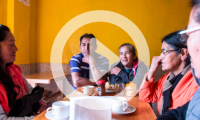
Diego Chaves-González
Senior Manager, Latin America and Caribbean Initiative
Diego Chaves-González is Senior Manager for MPI's Latin America and Caribbean Initiative, which aims to create dialogue and foster the exchange of innovative policy ideas among Latin American governments and their partners. Mr. Chaves-González’s research focuses on forced displacement, legal pathways, integration, migration and development, and regional cooperation in migration management.
|
Media Requests |
He previously worked for the World Bank and the United Nations. While at the World Bank, he helped expand the scope of the Global Concessional Financing Facility (GCFF). He also co-authored the 2019, 2020, and 2021 GCFF annual reports, and helped coordinate the Secretary of the Multilateral Development Bank platform. While working for the United Nations, Mr. Chaves-González initiated a platform in Colombia to coordinate the work of UN agencies, NGOs, and their partners in response to migrant and refugee situations. He also helped develop a strategy to involve victims of conflict and internally displaced persons in the peace deal negotiations that ended Colombia’s civil war.
Mr. Chaves-González also played an essential role as a presidential advisor in the registration and regularization of 500,000 migrants in Colombia and helped provide advice on how to structure similar initiatives in Costa Rica, Ecuador, and Peru. Since the start of the Venezuelan crisis, he has assisted Latin American governments in developing policies to integrate arriving migrants and refugees into receiving communities, accommodating both newcomer and local needs.
Mr. Chaves-González holds a master’s degree in economics and social development from Cardiff University, a master’s in public policy from Tecnológico de Monterrey, and a bachelor’s degree in political science and specialization in international relations from Pontificia Universidad Javeriana in Bogotá.
Bio Page Tabs
En esta conversación, líderes de ciudades medianas examinan las respuestas sociales de la region que han resultado en la integración de nuevos migrantes en comunidades locales.
Al reflexionar sobre los desafíos a corto y mediano plazo que enfrentan los venezolanos en Suramérica y el Caribe, líderes de la diáspora venezolana y miembros de la sociedad civil exploran lo que logró la conferencia de donantes y discuten alianzas e iniciativas prometedoras.
En dicho diálogo, algunos de los representantes de las organizaciones que conforman la red en Norteamérica, Centroamérica, Sudamérica y el Caribe, comparten la manera como se coordinan, las acciones que se llevan a cabo y las dificultades, retos y desafíos que atraviesan.
En este webinar, expertos de la región discutieron acerca del perfil demográfico de los refugiados y migrantes venezolanos en Argentina, Brasil, Chile, Colombia, Costa Rica, Ecuador, Guyana, Paraguay, Perú, Trinidad y Tobago y Uruguay.
Recent Activity
El desplazamiento de venezolanos ha llevado a países de toda América Latina y el Caribe a poner en marcha políticas y programas para registrar, regularizar y apoyar la integración de los venezolanos. Sin embargo, la medida en que la regularización ha ayudado a los venezolanos a encontrar trabajo ha variado de un país a otro, como se analiza en este informe.
Cerca de 855,000 inmigrantes colombianos residían en los Estados Unidos, lo que representa alrededor del 2 por ciento de los 45.3 millones de inmigrantes estadounidenses en general y el grupo más numeroso procedente de Sudamérica. Casi uno de cada cuatro inmigrantes de Sudamérica en los Estados Unidos procedía de Colombia.
Los países de América Latina y el Caribe están siendo transformados por crisis políticas y económicas, nuevos acuerdos de libre circulación y otras tendencias. La cantidad de inmigrantes que viven en la región casi se ha duplicado desde 2010, un cambio increíble en un corto período de tiempo. Este artículo da sentido a una profunda transición en curso en el hemisferio occidental.

















¿Qué sigue ahora luego de que Colombia haya dado un paso histórico en materia de migración?
What Comes Next Now that Colombia Has Taken a Historic Step on Migration?